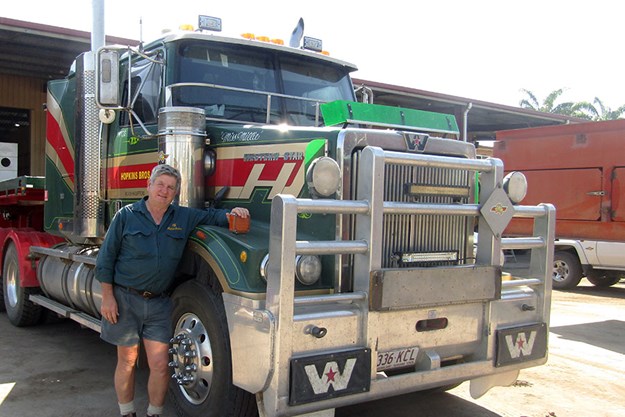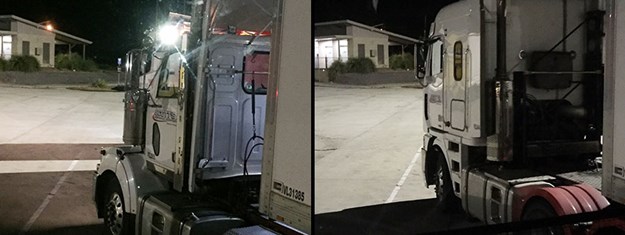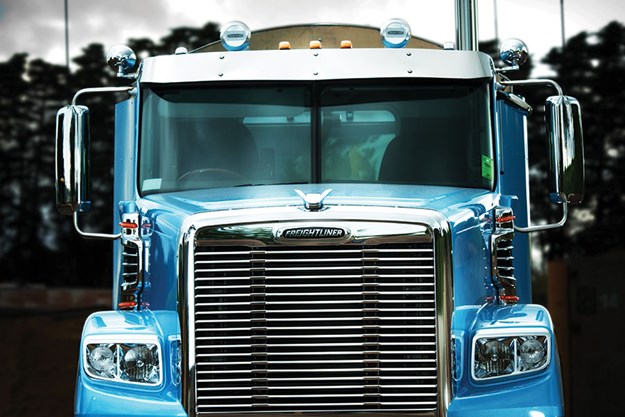Despite all the new electronic safety technology and Chain of Responsibility rules, the best tool to fight fatigue is still a bunk. But there are a lot of prime movers running at night without them, and that could present a legal risk.
You have to feel sorry for drivers who work at night in a day cab truck rather than a prime mover with a mattress in it.
Research has repeatedly shown that between about midnight and 6am is a very bad time to be trying to stay awake.
So what happens if a driver desperately needs a 15 or 20-minute power nap in this “zombie zone” because they had a bad sleep the previous day, or they just feel tired?
And what happens if they’re doing a changeover and the truck coming from the other end is running late; or if they’ve broken down and have to wait for help; or if the road is blocked because of a bushfire?
You can’t just recline the seat like in a car for a snooze. Some drivers reckon they can get shut-eye anywhere, but how would you go trying to sleep propped up against the driver’s window; or on the floor wrapped around the gearstick; or what about across the bucket seats if you’re lucky enough to have a panel that flips down in the middle or something you can legally stuff in to fill the gap; or under the trailers; or on the bonnet; or perhaps worst of all, slumped over the steering wheel, risking a subconscious association between the wheel and sleep?
All of this sort of thing might have been common in the old days but fifth-generation trucking operator Tony Hopkins doesn’t think it’s good enough in the modern era, especially when everyone is trying to get and keep good drivers.
“One time everyone had to do it because that was all that was available, but the industry has grown up, it’s improved its safety record,” Hopkins says. “We don’t want the safety to go backwards by denying people a good bunk.”
 |
|
Tony Hopkins, from the National Road Freighters Association, likes a big bunk
|
Tony is immediate past president of the National Road Freighters Association (NRFA). He’s co-owner of Hopkins Brothers in Rockhampton, a company which started out in livestock and can cart anything but specialises in both local and long distance quarry and soil products and heavy haulage.
The company has 30 trucks and 70 trailers, but only a few day cabs, for local tipper work and over-length cartage. “I wouldn’t use them on linehaul,” Tony says.
He reckons the eastern states’ 26 metre B-double envelope has often resulted in longer trailers and shorter sleepers – or no sleeper at all – to the detriment of driver comfort and safety.
The NRFA wants operators to be allowed another two metres on prime movers to allow drivers of bonneted trucks to have some extra room to move around in the cab, and space for a fridge and stove in remote areas on long breaks, for example.
Straight shooter
Does Tony think running day cabs long distances at night complies with the spirit of the Chain of Responsibility (COR) law on fatigue?
“No not at all,” he replies. “It slaps it in the face.”
Tony is by no means the only expert who believes common industry practices such as running day cabs at night or common situations such as having noisy bunkrooms could make for an interesting test case under the toughened COR law that came in just over a year ago.
That’s because the authorities basically no longer have to wait for an accident to happen to investigate and prosecute someone under COR.
 |
|
A Scott’s day cab Coronado changes over with an Argosy at Tarcutta, 3.30am
|
Under the “primary duties” in section 26c of the Heavy Vehicle National Law (HVNL): “Each party in the Chain of Responsibility for a heavy vehicle must ensure, so far as is reasonably practicable, the safety of the party’s transport activities relating to the vehicle.”
The law also says that to the extent it’s not reasonably practicable to eliminate public risks, they have to be at least minimised.
So to use the example of running day cabs at night when a lot of other competitors are running sleepers, is that doing everything “reasonably practicable” to minimise the risk to drivers and the public of fatigue?
It seems the Australian Trucking Association and the Australian Logistics Council may not think so.
On page 52 of their voluntary Master Industry Code of Practice under the heading “What You Can Do” as an operator to help manage fatigue, one of the recommendations is to “provide a comfortable sleeper berth”.
Logistics Council members include Coles and Woolworths, who of course have a lot of long distance trucking operators running into their distribution centres.
But in what could potentially have major implications for the entire trucking industry, the Master Code doesn’t limit its “comfortable sleeper berth” recommendation to just the long distance sector, or even just to big trucks.
The Code was produced last November and was funded and endorsed by the National Heavy Vehicle Regulator (NHVR) as part of helping operators comply with the HVNL, which is under review.
Minimising risks
COR expert Michael Crellin has a warning for the trucking industry about the risk of an issue like running day cabs at night becoming a legal test case.
“I suspect that may not be too far off,” Crellin says. “Something like that could become the focus of an investigation and prosecution.”
 |
|
Chain of Responsibility expert Michael Crellin
|
Crellin should know – he spent three years as head of COR for the NHVR until early 2018, and is now a consultant on COR to the entire supply chain, including trucking companies.
He investigated truck crashes in his earlier long career as a police officer in Queensland, and has a law degree, but stresses his advice is for best practice only – to have good systems in place to minimise both operational and legal risk.
“I don’t want to come out and say everybody should have a sleeper cab, because I think there are circumstances within our industry where we can use a day cab,” Crellin says.
“But the reality is if we are sending people on a longer journey at night-time when circadian rhythms suggest that’s when I should be asleep, then the probability of somebody becoming tired, becoming weary or drowsy, is heightened.
“I think logic needs to prevail and we need to say if there is a higher than normal probability that someone is going to become fatigued, then let’s at least give them the opportunity – should that situation arise – to get that sleep that they need. That may just be the 20 minute power nap and that may be enough for that person to be refreshed enough to carry on.
“While the law doesn’t prescribe that when we’re doing long distance work that we provide a sleeper cab for them, it actually makes good sense to do so because that way the driver can access the only solution to fatigue in real time, and that is sleep.
“Similarly with the placement or conditions of facilities that might be provided on site, we need to make sure they are getting quality sleep in order that they be properly refreshed before having to embark on the next journey.”
SLEEPING COMFORTABLY IN SUMMER
Crellin agrees the ATA/ALC Master Code may create a can of worms regarding where you draw the line on what types of trucking need sleeper cabs and which don’t. He says it’s not necessarily just linehaul at issue, and gives the example of pocket B-double day cab milk tanker drivers who often start early in the morning and sometimes do “massive” hours.
To that you could probably add many 19-metre fuel tanker drivers, and the list goes on.
Regulator’s response
The NHVR didn’t directly respond to Owner//Driver’s request for comments on the day cab issue.
However an NHVR spokesman says: “What is reasonably practicable for an operator will depend on all the relevant matters, including the likelihood of the safety risk, the harm that could result from the risk and whether the cost associated is grossly disproportionate to the likelihood of the risk.
“Factors such as the distance to be travelled, time of day, weather conditions, dimensions of the vehicle’s cab, availability of other sleeping or resting places along the route and the characteristics of the driver are some of the matters that would need to form part of the operator’s assessment of whether a sleeper berth is a reasonably practicable way to eliminate or reduce the hazard of fatigue.”
Operator view
A common sight on eastern Australia’s highways at night are day cabs operated by Scott’s Refrigerated Freightways (SRF).
SRF was until recently owned by big car and truck dealership company Automotive Holdings Group, as part of its AHG Refrigerated Logistics, which also includes Rand, Harris Refrigerated and JAT.
.jpg) |
| A Scott’s Refrigerated Freightways day cab near midnight at the Tarcutta changeover pad, halfway between Sydney and Melbourne. |
AHG has been taken over by another big motor vehicle dealership company, A.P. Eagers, which at the time of writing was negotiating with potential new buyers of the refrigerated logistics division.
A.P Eagers didn’t answer most of Owner//Driver’s questions about day cabs but in an emailed statement says: “Scott’s Refrigerated Freightways (SRF) has a strong safety track record and complies fully with NHVL and the National Heavy Vehicle Accreditation Scheme.
“SRF is one of many carriers in the transport industry operating day cabs at night. In the majority of these cases, drivers are conducting shuttles which enable them to return home to sleep at the end of their shift.
“In the small number of instances where day cabs are operating outside of a shuttle, SRF is an industry leader in its adoption of safe fatigue management practices through its access to an extensive depot network with onsite accommodation and an operations team that is well equipped to provide solutions for our drivers in the event of breakdown or delays, including identifying nearby accommodation or providing replacement drivers.”
Like many big overnight express operators, Scott’s shuttles are frequent, which helps managers to match drivers with someone else in the case of delays or breakdowns.
.jpg) |
|
Day cab drivers can only dream of something as spacious as this: Kenworth’s T610 1,400mm (55-inch) sleeper, for the long distance driver who needs a home away from home on their long breaks
|


